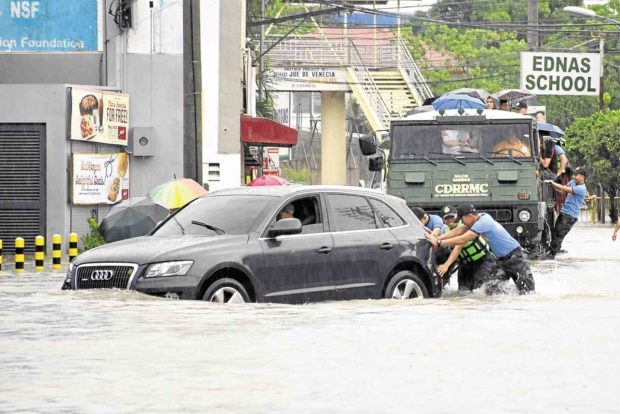2 kids dead in Agoo landslide

NO MATCH A luxury car stalls in the middle of flooded Perez Boulevard and had to be pushed in the village of Tapuac in Dagupan City. A state of calamity has been declared in the city to free up funds to be used for more than 30 villages which were submerged by floodwater. Other areas in Luzon were hit by flooding and landslides as monsoon rains made worse by a low pressure area continued to break rainfall records. In Pangasinan, officials said the amount of rain that fell was equivalent to three months’ worth of rainfall.—WILLIE LOMIBAO
DAGUPAN CITY — Two children were killed in La Union province while more than 600 families in Pangasinan province were evacuated as monsoon rains in the last three days triggered landslides and massive flooding.
John Jonard Galleros, 12, and his brother Joseph Galleros, 11, were already dead when rescuers pulled them out of thick mountain soil that buried their house on Friday at Barangay San Francisco in Agoo town.
The two boys were sleeping when four feet of mud fell on their house at 4 a.m. as heavy rains pounded the Ilocos and Cordillera regions on Friday night and Saturday morning.
On Saturday, the Dagupan council declared a state of calamity in the city to access funds for its 31 flooded villages. San Carlos City and Sta. Barbara also declared a state of calamity.
Ifugao
Lagawe in Ifugao province also declared a state of calamity because of floods and landslides that struck the capital town.
In Bulacan province, a state of calamity was also declared in flooded Paombong town.
High tide affected the City of Meycauayan but waters had since subsided. In Nueva Ecija, 2,584 families were displaced by floods that struck six villages in Licab town since Thursday night
The amount of rain that fell in the last three days in Pangasinan was equivalent to up to three months of rainfall, said Gov. Amado Espino III on Saturday.
In its 4 a.m. flood bulletin, the Agno River Basin Flood Forecasting and Warning Center said it had recorded an average rainfall of 105.4 millimeters since Friday morning.
The weather bureau in Baguio measured rainfall from 8 a.m. on Friday to 8 a.m. on Saturday at 201.6 millimeters, higher than 136 mm recorded in the city from July 18 to July 19.
147 villages
A total of 147 villages in 15 towns and in Dagupan, Alaminos and Urdaneta cities were flooded as monsoon rains caused rivers to swell.
Floods displaced almost 7,000 families, according to the provincial disaster risk reduction and management office.
But more families were expected to be evacuated as disaster response officials in Calasiao town and Dagupan City continued to rescue stranded residents.
The Ambuklao and Binga hydroelectric dams in Benguet province had been spilling water into the Agno River.
Operators of Ambuklao Dam opened seven spillway gates on Saturday when its reservoir water level rose to 750.66 meters above sea level (masl). Its normal high water level is 752 masl.
In a text message, Odette Rivero, spokesperson of the National Power Corp., said Ambuklao’s water inflow was 606.44 cubic meters per second (cms) and it was releasing water at a rate of 370.13 cms.
A cubic meter of water is equivalent to 1,000 liters or about five drums of water.
The Binga Dam opened six spillway gates when its water elevation reached 573.53 masl. —Reports from Gabriel Cardinoza, Yolanda Sotelo, Armand Galang and Carmen Reyes-Estrope














